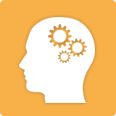Frequently asked questions about the Amplifire learning platform
The Science Behind the Learning
Our goal is to provide you with a focused, efficient path to mastering and retaining the information you need to be successful. The adaptive system you are using was developed based on scientific studies of how people can learn most efficiently. Key principles from these studies inform how the system works with you and adapts to your needs.

Why do I have to answer questions before I’ve learned anything?
Priming
Athletes warm up immediately before a game by doing drills and exercises that mimic the actions they’ll take in competition. Your brain works the same way! By first answering questions, you prime your brain to acquire new knowledge, creating a mental framework for the material to be learned.
Research shows that priming by answering multiple-choice questions before study dramatically prepares the mind for learning and retention.

Should I answer partially sure or that I don’t know?
Metacognition
We ask you to assess your confidence in your answer choices because studies have shown that thinking about your learning—also known as metacognition—is important for retention. Confronting what you know versus what you think you know activates the parts of your brain responsible for memory formation. fMRI scans of the brain confirm that when these areas are activated concurrently, learners store more information in long-term memory and experience greater engagement.

Can’t you just tell me what I need to know?
Retrieval Practice
We could—but you can learn more efficiently and effectively by answering questions. Multiple studies have shown that retrieval practice—the practice of recalling information—activates a huge array of mental processes. When you answer a question, you’re engaging in retrieval practice and strengthening your memory encoding. Research has shown that regular self-testing is the most effective study technique for retention of material.

Why do I see some questions more than once?
Desirable Difficulty
Remember, this is not a test—this is a learning system. Studies in gaming have shown that uncertainty, struggle, and eventual success drive user engagement. These same studies apply in learning. As you work, the system assesses your knowledge and adjusts the material you engage with. The result? You re-engage with material that was difficult for you. Overall, you optimize your learning by maintaining an ideal balance of challenge and progress.

Why can’t I see the correct answer and explanation right away?
Engineered Spacing
While you’ll receive immediate feedback on whether you were correct or incorrect, you’ll only see the full explanation and correct answer after an interval of time. We’re not doing this to be mean or to drive you crazy! This proven learning technique is called engineered spacing. Studies have shown that spacing not only drives engagement, but also drives more effective retrieval practice. By exposing you to some content via a question, then deliberately waiting to provide further context, we’re asking you to stow and retrieve information. This practice strengthens your neural connections, helping you efficiently recall and learn information.

Why should I refresh?
Forgetting Curves
Refresh is important because at some point you’re going to forget what you learned. In fact, scientists have built models called forgetting curves, which predict how and when you’ll forget learned information. However, forgetting curves differ from person to person due to a variety of inputs, such as strength of prior knowledge and time spent learning. Our system adapts to you and your unique knowledge levels. Based on your interactions in the program, the system can form an idea of when you are going to forget, and encourages you to refresh at the best time—just as your memory is starting to fade.